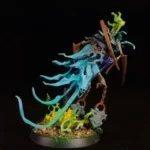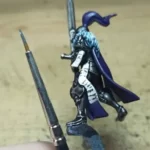Painting Miniature Skin Tones – The Ultimate Guide (photos)

Creating the right neutral tones for skin color can be challenging, especially if you’re a beginner painter.
You will need to understand color contrast and how they blend, but this can be more challenging as skin tones require a subtle mixture and application to create the right amount of paint color perfect for the job.
The good news is that knowing the right miniature painting technique for skin tones can guide you towards getting the right flesh color for your mins.
Understanding Skin Tones
Before painting skin tones, the first thing you need to know is that there are different types of flesh tones. Miniature skin tones are usually a variation of dark flesh, tanned browns, and light flesh.
Light skin tones are often called Caucasian skin and are typically associated with Space marines (Primaris), Stormcast Eternals, Astra Militarum, and most human figures.
Tanned flesh tones often look like Caucasian skin color but have more melanin, while dark flesh typically reflects African figures.
On the other hand, every skin reflects light sources depending on where the light is hitting. With dark flesh tone, creating strong highlights is key to creating interest and realism. To achieve this, you have to confine light highlights to small surfaces. This way, the overall skin color does not appear lighter than intended.
Mixing Skin Tones
Whether you’re a seasoned professional or a new painter, mixing flesh colors can be tricky, as paints respond differently to mixing. But, it becomes easier if you know the skin color you’re painting and how to blend them to get the results you want.
So, first things first, determine the skin color.
Once you know the type of skin you are painting, the colors you choose will depend on this flesh tone. Sure, it’s easy to distinguish between light, medium, and dark skin, but the tricky part of mixing flesh color to get the right effect is how well you paint the undertones.
For instance, if you’re painting light skin color, you may not consider using slightly dark neutron tones, but even Caucasian skin will need some amount of dark flesh to help the skin color blend well. By really considering the flesh tones you want to paint, you can make informed decisions when mixing paint.
Next, create a palette containing all the primary colors you need for mixing paint.
The primary colors will typically comprise different tones, from light to medium and dark. It’s good to have this palate around because it helps you decide on which accent to add next to modify the shade or attain the right details you want.
When mixing different shades, keep in mind that it is easy to change dark shades to much lighter tones, but darkening light paints to the right dark shades can be challenging. So, when mixing, always start with dark tones.
Applying Skin Tones to Miniature Models
Knowing how to paint miniature skin color accurately comes down to how you do the highlights and layering.
Regardless, the right way to use skin tones on miniature models is to apply the base coat, washes, highlights, and pigment tones where it applies.
Consider the following when painting miniature skin tones.
Note: in this part, we use A to represent Caucasian skin, B for tanned skin, and C for dark flesh.
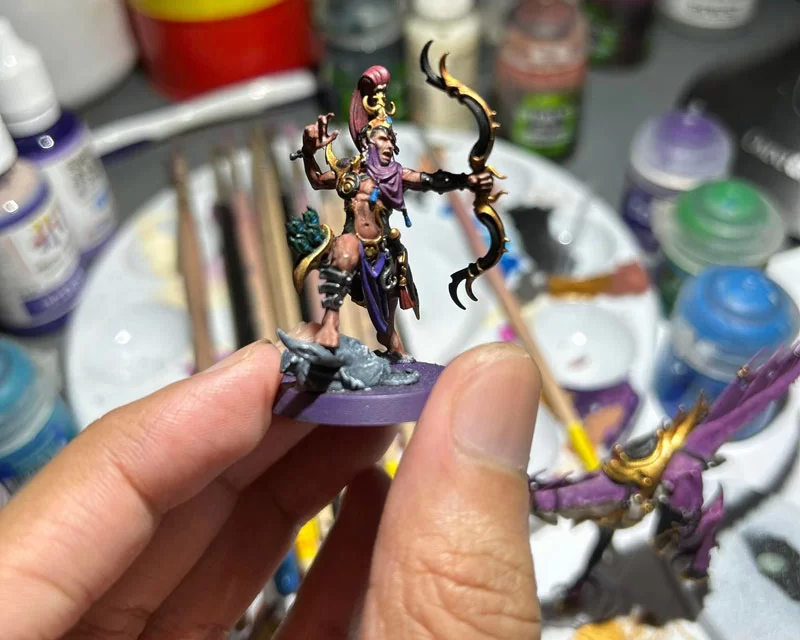

(Base color Bugmans Glow and Reiklan Fleshade
- Basecoat: If you’re using the Citadel paints, start with a watered-down Cadian Fleshtone basecoat color on A, 2 layers of XV-88 on B, and Rhinox Hide on C.
- Washes: apply Nuln oil as a wash on all skin colors.
- Highlights 1: Use the Cadian flesh tone again on A to give it a more realistic feel. Avoid painting the cracks and crevices with this color. Reapply the XV-88 on B and Rhinox Hide on C to regain some of the colors lost from the wash.
- Highlight 2 & 3: Apply a 50/50 highlight with the Cadian Flesh tone and Kislev flesh mix on A and B and a 50/50 mix of the Rhinox Hide and Doombull Brown on C to add life to the skin. You can be quite generous with the first layer but do smaller amounts on the second layer.
- Highlight 4: Add another highlight on A and B (up to three highlights) but with a pure Kislev Flesh, so it feels like you’re glazing the skin. On C, use the pure Doombull Brown sparingly but not so much that you lose the original vibe.
- Highlight 5: Mix Kislev white and White Scar to do the final highlights around the edges of your skin on A to show where light is hitting. Then use Doombull Brown and Kislev flesh on C. Make sure to keep it minimal as they can appear quite stark.
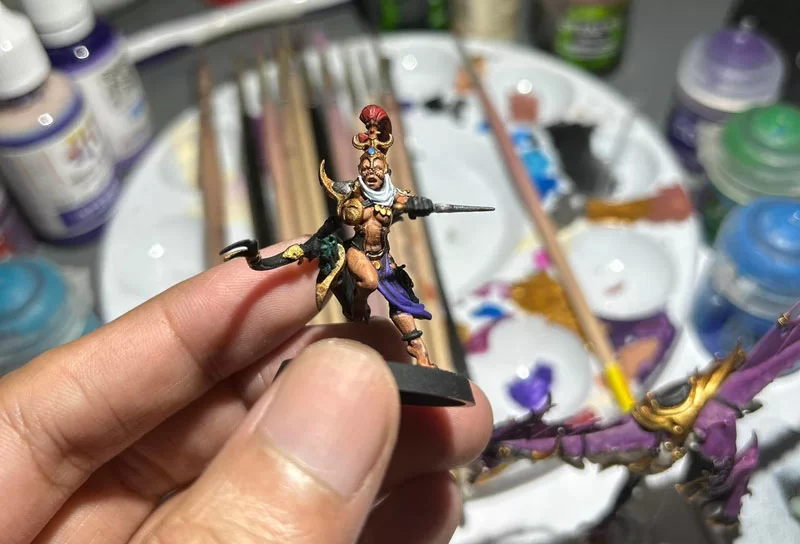

Base Bugman +Layer Cadian Flesh + Wash Reikland
Advanced Techniques for Painting Skin Tones
Every person has a unique skin color that sets them apart, but you will also find some unique features like light and blush that creates more details on their skin. These feature basic techniques that won’t teach you how to do them.
Once you’ve mastered the basic technique of painting miniature skin tones, it’s time to try these advanced techniques on your models.
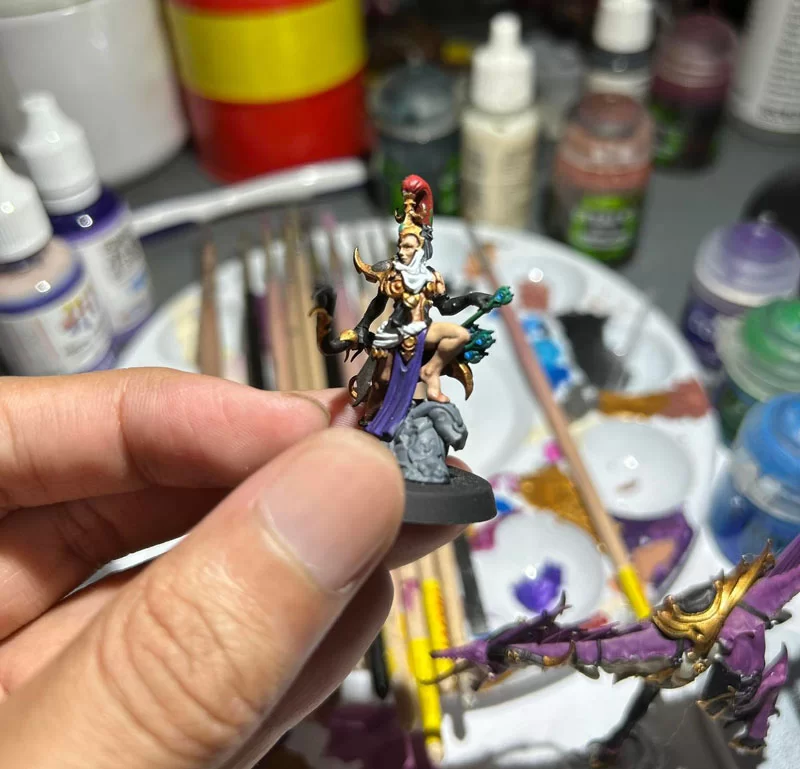

Base Bugman + layer cadian + wash reikland + layer dilluted kislev flesh
Creating Blush Effect
You will think that because it is the blush you can simply use pink or red paint to achieve the best result, but it doesn’t work like that. Instead of this, add some small drops of red paint into a light skin tone and mix. This mixture will help you create natural blush on the skin.
Light Effects
As the name implies, this effect shows where the light hits the skin. Most people use white to paint the light source, but one thing to keep in mind is that light reflects differently on the skin, especially if the model has a colorful base.
For instance, if your miniature figure is standing near a blue drape, a sliver of blue may appear on the skin. So, rather than use white as a light source, a light blue color will help you capture the blue details on the skin to make your painted miniature more lifelike.
Conclusion
Painting realistic skin on miniature models can be a daunting task with the different types of skin tones and mixing and application techniques you need to learn. But, as we mentioned earlier you only need to know the right technique to get the job right.
So, whether you’re new to miniature painting or have had some experience painting flesh tones, with more practice, creating flesh tones like a pro won’t be a hassle.


